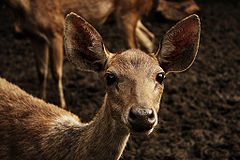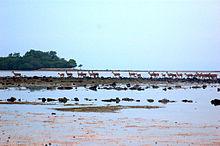- Javan Rusa
-
Javan Rusa[1] 
Rusa Deer Conservation status Scientific classification Kingdom: Animalia Phylum: Chordata Class: Mammalia Order: Artiodactyla Family: Cervidae Subfamily: Cervinae Genus: Rusa Species: R. timorensis Binomial name Rusa timorensis
Blainville, 1822The Javan Rusa or Sunda Sambar (Rusa timorensis) is a deer native to the islands of Java, Bali and Timor (shared with East Timor) in Indonesia. It is also an introduced species in Irian Jaya, Borneo (Kalimantan), the Lesser Sunda Islands, Maluku, Sulawesi, Australia, Mauritius, New Caledonia, New Zealand, Papua New Guinea, and Réunion.[2]
Contents
Habitat
It occupies a habitat similar to that of the Chital of India: open dry and mixed deciduous forests, parklands, and savannas. It is a close relative of the larger Sambar deer. It is moderately hunted in eastern Australasia.
Rusa Deer have established populations in remote islands, probably brought there by Indonesian fishermen. They adapt well, living as comfortably in the dry Australian bush as they do in their tropical homelands. This trait is shown well in the more frequent encounters on the fringes of Wollongong and Sydney, and in particular in the Royal National Park, indicating steadily growing numbers and strong herds.
Description
Rusa Deer are recognised by their large ears, the light tufts of hair above the eyebrows, the antlers appearing too large for their body size.
Behaviour
 Herd of Rusa Deers in Baluran National Park
Herd of Rusa Deers in Baluran National Park
Rusa Deer are active mostly in the early morning and late afternoon. They are rarely seen in the open and are very difficult to approach due to their keen senses and cautious instincts.
When spooked, a Rusa stag lets out an extremely loud honk. This is an alarm call and will alert any other deer in the vicinity.
Rusa Deer are very sociable and seldom found alone; even if one seems to be alone it probably is not. These animals are so well camouflaged they may sometimes let a person walk right past them.
Reproduction
Javan Rusa breed around July and August in a period known as the rut. At this time stags battle for dominance and breeding rights, contesting them by calling in a loud shrill bark and physical contact with the antlers. Calves are born at the start of spring. Maturity is attained in three to five years, depending on conditions and habitat.
Subspecies
Seven subspecies of Rusa timorensis are recognised:[1]
- R. t. timorensis
- R. t. djonga – Muna and Butung Islands;
- R. t. floresiensis (Flores Rusa Deer) – Lombok and other islands;
- R. t. macassaricus (Celebes Rusa Deer) – Celebes;
- R. t. moluccensis (Moluccan Rusa Deer) – Molucca Islands;
- R. t. renschi (Moluccan Rusa Deer) – Molucca Islands;
- R. t. russa (Javan Rusa Deer) – Java.
References
- ^ a b Grubb, Peter (16 November 2005). "Rusa timorensis". In Wilson, Don E., and Reeder, DeeAnn M., eds. Mammal Species of the World: A Taxonomic and Geographic Reference (3rd ed.). Baltimore: Johns Hopkins University Press, 2 vols. (2142 pp.). p. 670. ISBN 978-0-8018-8221-0. OCLC 62265494. http://www.bucknell.edu/msw3/browse.asp?id=14200445.
- ^ a b Hedges, S., Duckworth, J.W., Timmins, R.J., Semiadi, G. & Priyono, A. (2008). Rusa timorensis. In: IUCN 2008. IUCN Red List of Threatened Species. Downloaded on 9 April 2009. Database entry includes a brief justification of why this species is of vulnerable.
External links
Categories:- IUCN Red List vulnerable species
- Mammals of Asia
- Mammals of Indonesia
- Megafauna of Eurasia
- Mammals of Borneo
- Cervines
- Animals described in 1822
Wikimedia Foundation. 2010.

